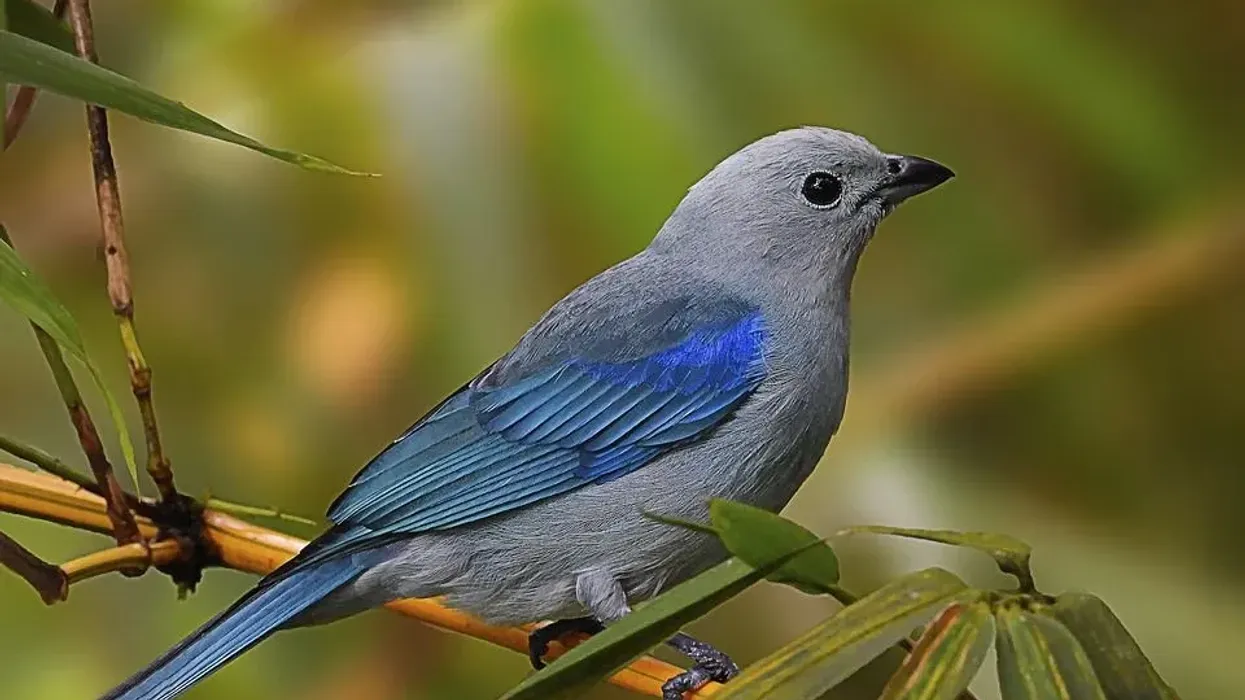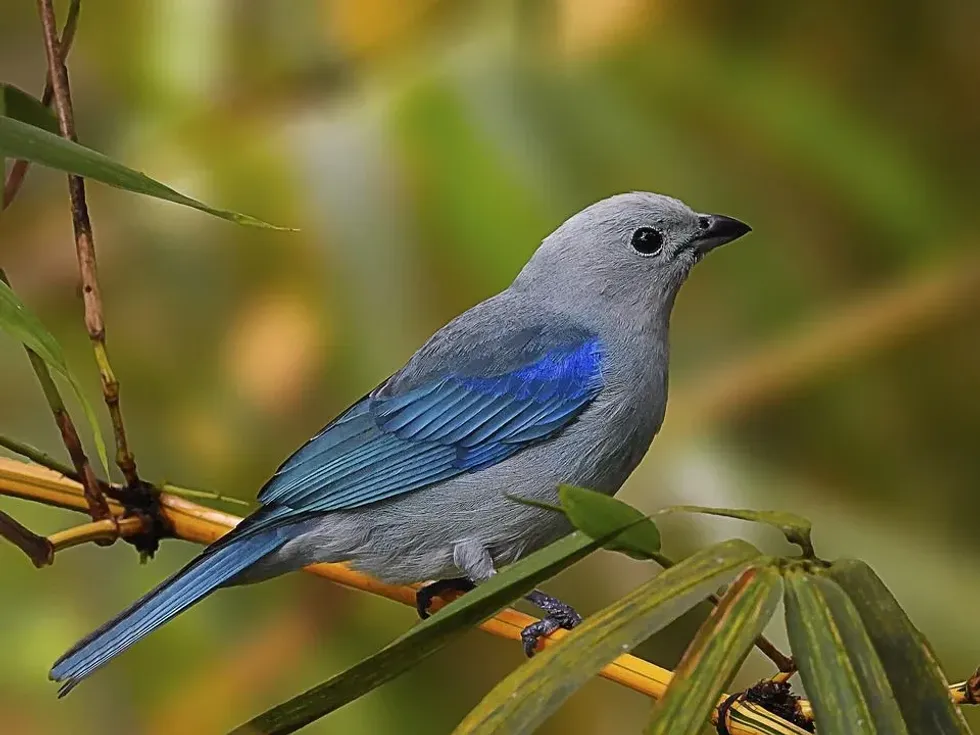Tanagers are songbirds that make up the Thraupidae tribe. Approximately 240 species of colorful fruit-eating birds are included in this family like the palm tanager, orange tanager, blue tanager, yellow tanager, blue-gray tanager, red tanager, golden hooded tanager, and many more.
These are small to medium birds in size that have the tiniest of bodies and possess bills of different shapes that vary from bird to bird. These species are indigenous to South America and they are widespread in Central America, South America, and North America.
The northernmost range of the western tanager extends into the northwest territories of Canada.
These birds live in nests that they construct at tall treetops and these birds have a diet that includes insects, seeds, fruits, flower parts, and nectar. Their IUCN conservation status is Least Concern.
If you love reading about the stunning tanager bird, then check out our fact files about the western tanager and the summer tanager too.
Tanager Interesting Facts
What type of animal is a tanager?
Tanager birds are brightly colored birds that are omnivorous belonging to the family Thraupidae and order Passeriformes.
What class of animal does a tanager belong to?
They belong to the class Aves and order Passeriformes. These species can be bright red, yellow, green, blue, turquoise, black, white, and orange.
How many tanagers are there in the world?
There is no data regarding the overall population of all tanagers. However, these colorful species of birds that comprise the Thraupidae family are widespread in America. The estimated population of the summer tanager species is 12,000,000 in the United States and the population of western tanagers in Canada is 15,000,000. Overall there are 239 species of tanagers!
Where does a tanager live?
Look towards the treetops in forests to spot these birds and their nests. Tanagers, like the stunning summer tanagers, like to stay up high in the forests.
Due to that, it's hard to spot summer tanagers. These birds are indigenous to South America and tanagers are only found in parts of America.
The scarlet tanager (P. olivacea), western tanager (P. ludoviciana), and summer tanager (P. rubra) are the three types of tanagers that breed in North America. The hepatic tanager (Piranga flava) has a wider breeding range, spanning from southern Arizona to central Argentina.
From Mexico southward, Euphonias can be found. The gray or blue-gray tanager is the most abundant species and is found from Mexico to Peru and now also in Florida.
What is a tanager's habitat?
Tanagers are arboreal, meaning that they live in treetops, underbrush, or shrubbery. Tanagers are only found in the Western Hemisphere, mostly in the tropics.
Tanagers in South America make up about 60% of the world's population of this species, with the Andes accounting for 30%. Most birds of this species are limited to a geographic region. They also migrate.
Tanagers such as western tanagers migrate towards the north, from Arizona to the Northwest Territories, covering a wide area of the western United States and Canada, from wintering grounds in Central America and Mexico. Since western tanagers prefer wide habitats, deforestation has less influence on these birds than other birds
Who do tanagers live with?
Tanager species usually live in pairs with their significant other. They can also be found living with three to five other birds in groups. These groups could be made up of parents and their children. These birds can be found in both single-species and mixed flocks but some managers, like summer tanagers, prefer to live in solitude.
How long does a tanager live?
Tanagers live in the range of 12-17 years in captivity. Their life span in their natural environment is not yet known.
How do they reproduce?
The nesting habits of different species differ. The clutch size ranges between two to four eggs and females construct densely knitted nests out of fallen leaves and fibers.
The eggs are incubated by the female tanager for 12 days and fledglings are cared for by their parents before they develop wings within 12-14 days. Cowbirds (that lay eggs in their nesting sites) parasitize breeding tanagers, so they actively drive them away from nesting sites. Tanagers, like summer tanagers, breed near streams in lowland areas.
What is their conservation status?
Tanagers are widespread birds and are present in large numbers. Their conservation status is Least Concern as per the IUCN's Red List.
Tanager Fun Facts
What do tanagers look like?
Tanagers are small to medium-sized birds that have bills of varying shapes that are hooked and moderately toothed. The bills of these birds in the west are of greater length than the bills of tanagers in the east.
Some species have curved and slightly longer bills.
These species have short necks too, and these birds are well known for the vibrancy of their plumage which has hues of yellow, red, blue, black, and green in solid colors and is sometimes arranged in spectacular patterns. The sexes may be similar in color, or the female may be duller than the male.
How cute are they?
Tanagers are very cute birds thanks to their tiny bodies and vibrant colors. They are popular songbirds that have colorful feathers.
How do they communicate?
Tanagers, like the summer tanager, communicate with others around them through melodious songs, calls, or physical displays. The attention of females is caught by males by singing and even chasing them.
Male tanagers sing to protect their territory and sometimes chase their rival males too. At the start of the breeding season, they also counter-sing to respond to other males.
How big is a tanager?
Almost all birds of this species are within 4-11 in (9-28 cm) in length. They are double the size of hummingbirds.
How fast can a tanager fly?
These birds can fly at an average speed of 31 mph (50 kph).
How much does a tanager weigh?
They can weigh anywhere between the range of 0.2-4.02 oz (6-114 g).
What are the male and female names of the species?
There is no particular name for tanagers based on gender.
What would you call a baby tanager?
The babies of tanagers can be called fledglings, hatchlings, or chicks.
What do they eat?
These species of birds are omnivorous and fruit is an integral part of their diet. They also consume nectar, seeds, insects, bees, and flower parts.
Tanagers hover with rapid wing beats to catch insects that are on flowers, barks, or leaves. Tanagers can also grab flying insects like bees. Their major predators are owls and merlins but other predators that prey on their eggs are American crows, squirrels, snakes, and chipmunks.
Are they friendly?
They are not known to harm humans. Males sing to defend their territory and, on rare occasions, to scare away competing males. They also counter-sing to reply to other males at the start of the mating season.
Would they make a good pet?
They are not common as pets since they eat insects. If they are to be kept as pets, special care and supervision should be paid to their birdhouses, taking into account their environmental needs.
Did you know...
There are 39 species with the name 'tanager' that are not included in the Thraupidae family including the significant scarlet tanager and the western tanager, which are both included in the Cardinalidae family.
Summer tanagers, found in North America, are completely bright red-colored.
The oldest male summer tanager discovered was seven years old!
Types of tanager
There are numerous varieties of tanager species, such as the green-headed tanager, golden hooded tanager, seven-colored tanager, paradise tanager, eastern tanager, western tanager, scarlet tanager, hepatic tanager, and many, many more!
What does tanager mean and how to pronounce it?
The Tupi term 'tangara' is the origin of the word 'tanager'. It is pronounced simply as tan-a-ger.
Here at Kidadl, we have carefully created lots of interesting family-friendly animal fact files for everyone to discover! Learn more about some other birds including birds of paradise or the yellow warbler.
You can even occupy yourself at home by drawing one on our Tanager coloring pages.










